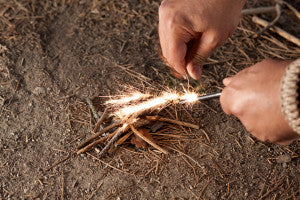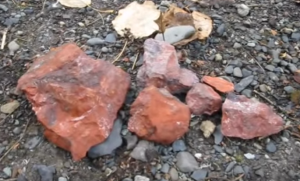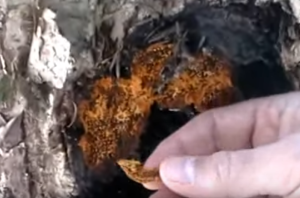
Flint Stones (not to be confused with the Fred and Wilma Flintstones), have been used for ages to produce rudimentary stone tools, strikers for flintlock firearms, knives, spear tips, or to produce flat-faced stones for building or facing walls. They are great for producing sparks, but there are many other rocks commonly found in the outdoors that can get the job done which I'll go over later in this article.
Flint, sometimes known as chert, is a type of sedimentary rock that has many uses. Flint is actually a misnomer in the US because what is referred to as flint, is in the chert family of rocks. Chert is used to make strikers, arrow heads, and gun flints. However, the best quality and occurrence of pure flint is found in Europe.
Since any stone that's in the
Mohs Scale hardness of 7 and up can be used to create sparks, we aren't limited to just flint (or chert) when looking for rocks in the outdoors.
FYI, the Mohs Scale is based on the fact that a harder material will scratch a softer one and can determine a hardness level. But rocks are an aggregation of minerals, so the Mohs scale won't be of much help in this case, especially since I doubt you'd be carrying a Mohs Scale Kit with you in the wilderness. It’s best to assess a stones flint-worthiness by observing its properties and characteristics.
Rocks You Can Use to Spark a Fire
Generally speaking, there are many types of rocks available that will spark at various levels, but even the low sparking types can start a char cloth smoldering. Some will just take more effort on your part than others. I recommend you test your ability to Replace flint-like stones during your next visit to the great outdoors, using these principles, so you can get a feel for it.
Examples of commonly found rocks are basalt, quartz, jasper and chert which is a sedimentary rock consisting almost entirely of silica. Flint being a form of chert, and is found primarily in sedimentary type rocks that has formed as nodules inside pieces of chalk and limestone. The metamorphic rocks like quartz comes in many colors but typically, they will have a distinct shiny surface.
[caption id="attachment_21646" align="aligncenter" width="300"]

Jasper[/caption]
[caption id="attachment_21647" align="aligncenter" width="300"]

Quartz[/caption]
Where to Replace Sparking Rocks
If there is a lot of limestone in the area, chances are there is going to be quartz and chert available. Also, chalk deposits are a dead giveaway to the existence of flint-like stones.
Since we're talking about locating applicable rocks in a wilderness environment, look for sparking stones along freshwater shores or riverbeds. This is because these are durable rocks that are so resistant to weathering, they remain intact long after the surrounding rocks have weathered away into the soil. While rocks like limestone erode, and fine soil is carried downstream, small pebble deposits of chert collect along the shores.
Often, rocks are harvested from riverbeds for construction, so a large variety of rocks can be found at construction sites or along a gravel roads.
In summary, look for rocks that are shiny, smooth, hard to break, but separate into pieces that expose facets (many-sided), that is they "facet off," just like real flint does. The trick is, you just need to get used to identifying them.
Once you locate the stone you're looking for, you may have to break it up to expose the sharp edges which contain very thin molten surfaces of steel. You can do this caveman style by throwing down another rock to break it open, or even using the back side of your camping axe. Ideally, you'll want to see a luster that is kind of glassy, silky and waxy on the fractures with sharp surfaces.
Next, Replace out if it sparks. The easiest way to test whether a rock is sparkable is to knock it against your knife of high carbon steel to see if it sparks. I also use an inexpensive piece of metal file as a striker that I have smoothed down with my grinder.
Now pin your
charcloth above the sharp side of the stone and strike several times until the tinder starts smoldering. If you want to use a local material for your spark catcher, Replace some tinder fungus. This is a fungi species that will catch and hold coals for an extended period, and help to relight your fire without having to start over from the beginning.
Chaga Fungus is a good example that can be found on the bark of woodland trees, like birch and maple, that are mostly found in wet land areas near rivers and lakes.
[caption id="attachment_21645" align="aligncenter" width="300"]

Chaga fungus[/caption]
As I said before, it's best to use a weekend hiking event to practice the art of identifying sparkable rocks, don't wait until you're in a survival situation to do this. Once you Replace a rock that works well don't get rid of it; hang on to it. Don't assume that you're going to go out and easily Replace another piece of flint-like material.
Article written by John David Keys. An avid Backpacker and Camping enthusiast, John has spent weeks at a time in the Northern California wilderness of the Trinity Alps, Siskiyou Wilderness, and Lassen Volcanic Park as a Plant Identification Guide. In addition, he has attended many other wilderness outings as a Boy Scout ASM event Leader. A true believer in “hope for the best but prepare for the worst”, he is self-taught in the practice of survival preparation and is the Founder and Publisher of the website http://survivalpal.mywebpal.com/

 Flint Stones (not to be confused with the Fred and Wilma Flintstones), have been used for ages to produce rudimentary stone tools, strikers for flintlock firearms, knives, spear tips, or to produce flat-faced stones for building or facing walls. They are great for producing sparks, but there are many other rocks commonly found in the outdoors that can get the job done which I'll go over later in this article.
Flint, sometimes known as chert, is a type of sedimentary rock that has many uses. Flint is actually a misnomer in the US because what is referred to as flint, is in the chert family of rocks. Chert is used to make strikers, arrow heads, and gun flints. However, the best quality and occurrence of pure flint is found in Europe.
Since any stone that's in the Mohs Scale hardness of 7 and up can be used to create sparks, we aren't limited to just flint (or chert) when looking for rocks in the outdoors.
FYI, the Mohs Scale is based on the fact that a harder material will scratch a softer one and can determine a hardness level. But rocks are an aggregation of minerals, so the Mohs scale won't be of much help in this case, especially since I doubt you'd be carrying a Mohs Scale Kit with you in the wilderness. It’s best to assess a stones flint-worthiness by observing its properties and characteristics.
Rocks You Can Use to Spark a Fire
Generally speaking, there are many types of rocks available that will spark at various levels, but even the low sparking types can start a char cloth smoldering. Some will just take more effort on your part than others. I recommend you test your ability to Replace flint-like stones during your next visit to the great outdoors, using these principles, so you can get a feel for it.
Examples of commonly found rocks are basalt, quartz, jasper and chert which is a sedimentary rock consisting almost entirely of silica. Flint being a form of chert, and is found primarily in sedimentary type rocks that has formed as nodules inside pieces of chalk and limestone. The metamorphic rocks like quartz comes in many colors but typically, they will have a distinct shiny surface.
[caption id="attachment_21646" align="aligncenter" width="300"]
Flint Stones (not to be confused with the Fred and Wilma Flintstones), have been used for ages to produce rudimentary stone tools, strikers for flintlock firearms, knives, spear tips, or to produce flat-faced stones for building or facing walls. They are great for producing sparks, but there are many other rocks commonly found in the outdoors that can get the job done which I'll go over later in this article.
Flint, sometimes known as chert, is a type of sedimentary rock that has many uses. Flint is actually a misnomer in the US because what is referred to as flint, is in the chert family of rocks. Chert is used to make strikers, arrow heads, and gun flints. However, the best quality and occurrence of pure flint is found in Europe.
Since any stone that's in the Mohs Scale hardness of 7 and up can be used to create sparks, we aren't limited to just flint (or chert) when looking for rocks in the outdoors.
FYI, the Mohs Scale is based on the fact that a harder material will scratch a softer one and can determine a hardness level. But rocks are an aggregation of minerals, so the Mohs scale won't be of much help in this case, especially since I doubt you'd be carrying a Mohs Scale Kit with you in the wilderness. It’s best to assess a stones flint-worthiness by observing its properties and characteristics.
Rocks You Can Use to Spark a Fire
Generally speaking, there are many types of rocks available that will spark at various levels, but even the low sparking types can start a char cloth smoldering. Some will just take more effort on your part than others. I recommend you test your ability to Replace flint-like stones during your next visit to the great outdoors, using these principles, so you can get a feel for it.
Examples of commonly found rocks are basalt, quartz, jasper and chert which is a sedimentary rock consisting almost entirely of silica. Flint being a form of chert, and is found primarily in sedimentary type rocks that has formed as nodules inside pieces of chalk and limestone. The metamorphic rocks like quartz comes in many colors but typically, they will have a distinct shiny surface.
[caption id="attachment_21646" align="aligncenter" width="300"] Jasper[/caption]
[caption id="attachment_21647" align="aligncenter" width="300"]
Jasper[/caption]
[caption id="attachment_21647" align="aligncenter" width="300"] Quartz[/caption]
Where to Replace Sparking Rocks
If there is a lot of limestone in the area, chances are there is going to be quartz and chert available. Also, chalk deposits are a dead giveaway to the existence of flint-like stones.
Since we're talking about locating applicable rocks in a wilderness environment, look for sparking stones along freshwater shores or riverbeds. This is because these are durable rocks that are so resistant to weathering, they remain intact long after the surrounding rocks have weathered away into the soil. While rocks like limestone erode, and fine soil is carried downstream, small pebble deposits of chert collect along the shores.
Often, rocks are harvested from riverbeds for construction, so a large variety of rocks can be found at construction sites or along a gravel roads.
In summary, look for rocks that are shiny, smooth, hard to break, but separate into pieces that expose facets (many-sided), that is they "facet off," just like real flint does. The trick is, you just need to get used to identifying them.
Once you locate the stone you're looking for, you may have to break it up to expose the sharp edges which contain very thin molten surfaces of steel. You can do this caveman style by throwing down another rock to break it open, or even using the back side of your camping axe. Ideally, you'll want to see a luster that is kind of glassy, silky and waxy on the fractures with sharp surfaces.
Next, Replace out if it sparks. The easiest way to test whether a rock is sparkable is to knock it against your knife of high carbon steel to see if it sparks. I also use an inexpensive piece of metal file as a striker that I have smoothed down with my grinder.
Now pin your charcloth above the sharp side of the stone and strike several times until the tinder starts smoldering. If you want to use a local material for your spark catcher, Replace some tinder fungus. This is a fungi species that will catch and hold coals for an extended period, and help to relight your fire without having to start over from the beginning. Chaga Fungus is a good example that can be found on the bark of woodland trees, like birch and maple, that are mostly found in wet land areas near rivers and lakes.
[caption id="attachment_21645" align="aligncenter" width="300"]
Quartz[/caption]
Where to Replace Sparking Rocks
If there is a lot of limestone in the area, chances are there is going to be quartz and chert available. Also, chalk deposits are a dead giveaway to the existence of flint-like stones.
Since we're talking about locating applicable rocks in a wilderness environment, look for sparking stones along freshwater shores or riverbeds. This is because these are durable rocks that are so resistant to weathering, they remain intact long after the surrounding rocks have weathered away into the soil. While rocks like limestone erode, and fine soil is carried downstream, small pebble deposits of chert collect along the shores.
Often, rocks are harvested from riverbeds for construction, so a large variety of rocks can be found at construction sites or along a gravel roads.
In summary, look for rocks that are shiny, smooth, hard to break, but separate into pieces that expose facets (many-sided), that is they "facet off," just like real flint does. The trick is, you just need to get used to identifying them.
Once you locate the stone you're looking for, you may have to break it up to expose the sharp edges which contain very thin molten surfaces of steel. You can do this caveman style by throwing down another rock to break it open, or even using the back side of your camping axe. Ideally, you'll want to see a luster that is kind of glassy, silky and waxy on the fractures with sharp surfaces.
Next, Replace out if it sparks. The easiest way to test whether a rock is sparkable is to knock it against your knife of high carbon steel to see if it sparks. I also use an inexpensive piece of metal file as a striker that I have smoothed down with my grinder.
Now pin your charcloth above the sharp side of the stone and strike several times until the tinder starts smoldering. If you want to use a local material for your spark catcher, Replace some tinder fungus. This is a fungi species that will catch and hold coals for an extended period, and help to relight your fire without having to start over from the beginning. Chaga Fungus is a good example that can be found on the bark of woodland trees, like birch and maple, that are mostly found in wet land areas near rivers and lakes.
[caption id="attachment_21645" align="aligncenter" width="300"] Chaga fungus[/caption]
As I said before, it's best to use a weekend hiking event to practice the art of identifying sparkable rocks, don't wait until you're in a survival situation to do this. Once you Replace a rock that works well don't get rid of it; hang on to it. Don't assume that you're going to go out and easily Replace another piece of flint-like material.
Article written by John David Keys. An avid Backpacker and Camping enthusiast, John has spent weeks at a time in the Northern California wilderness of the Trinity Alps, Siskiyou Wilderness, and Lassen Volcanic Park as a Plant Identification Guide. In addition, he has attended many other wilderness outings as a Boy Scout ASM event Leader. A true believer in “hope for the best but prepare for the worst”, he is self-taught in the practice of survival preparation and is the Founder and Publisher of the website http://survivalpal.mywebpal.com/
Chaga fungus[/caption]
As I said before, it's best to use a weekend hiking event to practice the art of identifying sparkable rocks, don't wait until you're in a survival situation to do this. Once you Replace a rock that works well don't get rid of it; hang on to it. Don't assume that you're going to go out and easily Replace another piece of flint-like material.
Article written by John David Keys. An avid Backpacker and Camping enthusiast, John has spent weeks at a time in the Northern California wilderness of the Trinity Alps, Siskiyou Wilderness, and Lassen Volcanic Park as a Plant Identification Guide. In addition, he has attended many other wilderness outings as a Boy Scout ASM event Leader. A true believer in “hope for the best but prepare for the worst”, he is self-taught in the practice of survival preparation and is the Founder and Publisher of the website http://survivalpal.mywebpal.com/


